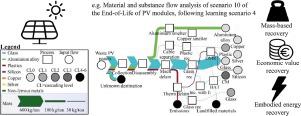Resources, Conservation and Recycling ( IF 11.2 ) Pub Date : 2021-10-06 , DOI: 10.1016/j.resconrec.2021.105917 Gwenny Thomassen 1, 2 , Jo Dewulf 1 , Steven Van Passel 2

|
The approaching end-of life phase of early installed PV modules gave rise to a variety of potential end-of-life strategies, ranging from basic generic waste management strategies to advanced case-specific recycling options. However, no comprehensive assessment on the full range of technological possibilities is available and only limited attention was given to the material recovery rates of these different technologies in light of circular economy. In addition, current material recovery rates are indifferent towards the material value and the value of their secondary applications. Based on an extensive literature review, ten end-of-life scenarios with potential learning effects are identified and their material flows are quantified using a combined material and substance flow analysis. Subsequently, material recovery rates from a mass, economic value and embodied energy perspective are calculated, incorporating the differences in secondary applications. The differences in the mass-based recovery rates of the seven end-of-life scenarios that did not have landfill or municipal waste incineration as the main destination were minimal, as 73-79% of the mass was recovered for the best-case learning scenario. For the economic value recovery rate (9-66%) and the embodied energy recovery rate (18-45%), more profound differences were found. The collection rate was identified as most crucial parameter for all end-of-life scenarios, learning scenarios and recycling indicators. The mass-based recovery rate might favor end-of-life scenarios that lead to dissipation of valuable materials in non-functional secondary applications. Additional targets are required to avoid cascading of valuable materials and to avoid the economic cost and environmental burden of virgin materials.
中文翻译:

晶体硅基光伏组件寿命终止阶段的预期材料和物质流分析
早期安装的光伏组件即将报废阶段引发了各种潜在的报废策略,从基本的通用废物管理策略到先进的特定案例回收选项。但是,没有对所有技术可能性进行全面评估,并且鉴于循环经济对这些不同技术的材料回收率给予了有限的关注。此外,目前的材料回收率对材料价值及其二次应用价值无动于衷。根据广泛的文献综述,确定了具有潜在学习影响的十种生命终结情景,并使用组合材料和物质流分析来量化它们的物质流。随后,物料的回收率,计算经济价值和体现的能源观点,并结合二次应用的差异。七个没有垃圾填埋场或城市垃圾焚烧作为主要目的地的报废场景的基于质量的回收率差异很小,因为最佳案例学习回收了 73-79% 的质量设想。经济价值回收率(9-66%)和隐含能源回收率(18-45%)差异较大。收集率被确定为所有报废情景、学习情景和回收指标的最关键参数。基于质量的回收率可能有利于导致非功能性二次应用中有价值材料耗散的报废情况。











































 京公网安备 11010802027423号
京公网安备 11010802027423号